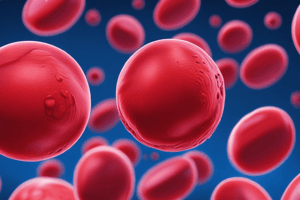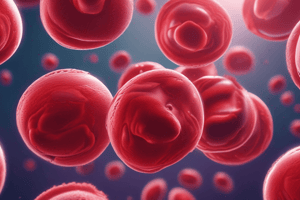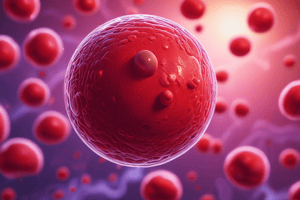Podcast
Questions and Answers
Aká je približná dĺžka života erytrocytov?
Aká je približná dĺžka života erytrocytov?
- 30 dní
- 60 dní
- 120 dní (correct)
- 180 dní
Ktoré z nasledujúcich stavov sú príznaky anémie?
Ktoré z nasledujúcich stavov sú príznaky anémie?
- Zvýšený krvný tlak
- Únava (correct)
- Zhoršenie zraku
- Nadmerná energia
Ktorý z nasledujúcich typov anémie je spojený s nedostatkom železa?
Ktorý z nasledujúcich typov anémie je spojený s nedostatkom železa?
- Anémia z nedostatku železa (correct)
- Aplastická anémia
- Anémia z nedostatku vitamínu B12
- Hemolytická anémia
Čo znamená nízka koncentrácia hemoglobínu v krvnom obraze?
Čo znamená nízka koncentrácia hemoglobínu v krvnom obraze?
Kde sú odstránené staré alebo poškodené erytrocyty z krvi?
Kde sú odstránené staré alebo poškodené erytrocyty z krvi?
Aká je hlavná funkcia erytrocytov?
Aká je hlavná funkcia erytrocytov?
Čo zvyšuje účinnosť výmeny plynov v erytrocytoch?
Čo zvyšuje účinnosť výmeny plynov v erytrocytoch?
Aká je štruktúra hemoglobínu?
Aká je štruktúra hemoglobínu?
Aký proces zabezpečuje výrobu erytrocytov v kostnej dreni?
Aký proces zabezpečuje výrobu erytrocytov v kostnej dreni?
Akú úlohu hrá parciálny tlak kyslíka v procese transportu kyslíka erytrocytmi?
Akú úlohu hrá parciálny tlak kyslíka v procese transportu kyslíka erytrocytmi?
Akým spôsobom ovplyvňuje erythropoietin (EPO) produkciu erytrocytov?
Akým spôsobom ovplyvňuje erythropoietin (EPO) produkciu erytrocytov?
Aký je vplyv hemoglobínu na oxidačné procesy v pľúcach a tkanivách?
Aký je vplyv hemoglobínu na oxidačné procesy v pľúcach a tkanivách?
Čo obmedzuje priestor pre hemoglobín v erytrocytoch?
Čo obmedzuje priestor pre hemoglobín v erytrocytoch?
Flashcards
Čo sú červené krvinky?
Čo sú červené krvinky?
Červené krvinky, tiež známe ako erytrocyty, sú najpočetnejším typom krvných buniek. Sú zodpovedné za prenos kyslíka z pľúc do tkanív a oxidu uhličitého z tkanív do pľúc.
Aký tvar majú červené krvinky?
Aký tvar majú červené krvinky?
Erytrocyty sú bikonkávne diskovité bunky, čo im dáva veľký pomer povrchu k objemu. To zvyšuje ich účinnosť pri výmene plynov.
Prečo červené krvinky nemajú jadrá?
Prečo červené krvinky nemajú jadrá?
Erytrocity nemajú jadrá ani väčšinu organel, čo umožňuje viac miesta pre hemoglobín. Toto prispieva k účinnejšej preprave kyslíka.
Čo je hemoglobín?
Čo je hemoglobín?
Signup and view all the flashcards
Ako hemoglobín viaže kyslík?
Ako hemoglobín viaže kyslík?
Signup and view all the flashcards
Ako sa tvoria červené krvinky?
Ako sa tvoria červené krvinky?
Signup and view all the flashcards
Čo reguluje tvorbu červených krviniek?
Čo reguluje tvorbu červených krviniek?
Signup and view all the flashcards
Čo ovplyvňuje tvorbu červených krviniek?
Čo ovplyvňuje tvorbu červených krviniek?
Signup and view all the flashcards
Životnosť červených krviniek
Životnosť červených krviniek
Signup and view all the flashcards
Odstraňovanie červených krviniek
Odstraňovanie červených krviniek
Signup and view all the flashcards
Recyklácia železa
Recyklácia železa
Signup and view all the flashcards
Anemia
Anemia
Signup and view all the flashcards
Typy anémie
Typy anémie
Signup and view all the flashcards
Study Notes
Erythrocytes (Red Blood Cells)
- Red blood cells, also known as erythrocytes, are the most abundant type of blood cell.
- They are responsible for transporting oxygen from the lungs to the tissues and carbon dioxide from the tissues to the lungs.
- Erythrocytes are biconcave discshaped cells, which gives them a large surface area-to-volume ratio, increasing their efficiency in gas exchange.
- They lack a nucleus and most organelles, allowing more space for hemoglobin.
- This specialized structure is essential for their function in oxygen transport.
Structure of Erythrocytes
- Erythrocytes are formed in the bone marrow through a process called erythropoiesis.
- They are primarily composed of hemoglobin, an iron-containing protein that binds to oxygen and carbon dioxide.
- The cell membrane of erythrocytes contains various proteins that are important for their flexibility and deformability. This allows them to squeeze through narrow capillaries to deliver oxygen to tissues.
Hemoglobin
- Hemoglobin is a complex quaternary protein composed of four polypeptide chains, each with an iron-containing heme group.
- Each heme group can bind to one molecule of oxygen.
- The binding of oxygen to hemoglobin is cooperative, meaning the binding of one oxygen molecule increases the affinity of hemoglobin for subsequent oxygen molecules.
- This cooperative binding is crucial for efficient oxygen uptake in the lungs and release in the tissues.
- Hemoglobin also binds to carbon dioxide, but to a lesser extent compared to oxygen.
Function of Erythrocytes
- Oxygen transport is the primary function of red blood cells.
- They carry oxygen from the lungs to the tissues and return carbon dioxide from the tissues to the lungs.
- This process is facilitated by the high affinity of hemoglobin for oxygen in the lungs and its lower affinity in the tissues.
- The partial pressure of oxygen plays a crucial role in this process.
- A low oxygen partial pressure in the tissues promotes oxygen release from hemoglobin.
Regulation of Erythropoiesis
- Erythropoiesis, the production of red blood cells, is tightly regulated by erythropoietin (EPO), a hormone produced by the kidneys.
- EPO stimulates the bone marrow to produce more red blood cells in response to oxygen-deficiency in the body.
- Various factors can influence erythropoiesis, including hormonal balance, nutritional requirements, and other metabolic processes.
Lifespan and Destruction
- Erythrocytes have a lifespan of approximately 120 days.
- Old or damaged red blood cells are removed from circulation by macrophages in the spleen and liver.
- The breakdown of hemoglobin releases its components, such as iron, which is recycled for reuse.
Anemia and Other Related Conditions
- Anemia is a condition characterized by a deficiency of red blood cells or hemoglobin.
- It can lead to various symptoms, such as fatigue, weakness, and shortness of breath.
- Different types of anemia are possible based on their cause.
- Examples include iron deficiency anemia, vitamin B12 deficiency anemia, and aplastic anemia.
Clinical Significance
- Measurement of red blood cell count (RBC count), hemoglobin concentration, and hematocrit (percentage of blood composed of red blood cells) are important diagnostic tools for evaluating overall health.
- Abnormalities in erythrocyte structure and function can indicate underlying medical conditions.
- Many diseases can be suspected based on abnormal erythrocyte analysis of the blood.
Studying That Suits You
Use AI to generate personalized quizzes and flashcards to suit your learning preferences.




